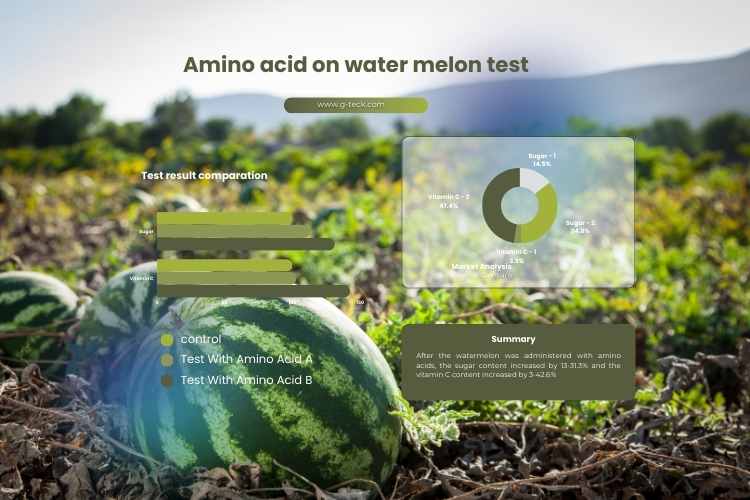Amino acid is a popular biostimulant widely used in the field of agricultural fertilization, or directly as organic nitrogen sources. What makes amino acids the first choice for such applications?
In detail the functions and advantages of amino acid fertilizers have the following six points:
1.Amino acids can promote photosynthesis in plants
Glycine in amino acids can increase the content of plant chlorophyll, promote the absorption and utilization of carbon dioxide by crops, increase power for photosynthesis, and make photosynthesis more vigorous.
2.A variety of amino acid mixed nutrition effect is good
The effect of amino acid mixed fertilizer is higher than that of single amino acid with the same amount of nitrogen, and also higher than that of inorganic nitrogen fertilizer with the same amount of nitrogen. A large number of amino acids improve the utilization rate of nutrients with its additive effect。
3.Fast fertilizer effect
Amino acids in amino acid fertilizers can be directly absorbed by various organs of plants, passively absorbed or osmotically absorbed under photosynthesis, and obvious effects can be observed in a short period of time after use. At the same time, it can promote the early maturity of crops and shorten the growth cycle.
4.Improve crop quality
Abundant amino acid species can improve crop quality. If the protein content of grain is increased by 3%, the cotton has good velvet quality and long fiber; vegetables have good palatability, pure and delicious taste, and crude fiber reduces the flowering period of flowers, bright colors and rich aroma, melons and fruits, large color and good sugar content, and more edible parts. The storage is good and the conversion benefit is remarkable.
5.Clean and pollution-free, improve the ecological environment
The amino acid fertilizer applied to the ground has no residue, which can improve the physical and chemical properties of the soil, improve the water and fertility retention and air permeability, and play the role of conservation, curing and soil improvement.
6.Enhanced metabolic function and improved resistance to stress
When amino acids are absorbed by crops, their physiological and biochemical functions can be strengthened. The stems of the crops are thick, the leaves are thickened, the leaf area is enlarged, the formation and accumulation of dry matter is accelerated, and the crops can mature earlier. Also due to their increased vitality, the resistance to cold and drought, the resistance to dry and hot wind, and the resistance to diseases and insect pests are improved, so as to achieve stable and high yields.
7.Well-developed root system, strong absorption
Amino acids have a special role in promoting the root development of crops. Many agricultural scientists call amino acids "root fertilizers". The main effect on the root system is to stimulate the division and growth of root meristem cells, so that the seedlings grow roots quickly. The number of secondary roots increases, the root volume increases, and the root system elongates, which ultimately leads to a greatly enhanced ability of crops to absorb water and nutrients
8.Effects on the growth of vegetative bodies in the aerial part
On the basis of sufficient nutrient supply, the stimulating effect of amino acids can make the aerial part of the plant grow vigorously, which is manifested in plant height, stem diameter, number of leaves, dry matter accumulation, etc.
9.Effects on yield and composition factors
Amino acids have differential effects on crop yield and compositional factors. It can increase the yield of grain crops, promote the growth of multiple spikes, increase the grain yield, and increase the thousand-grain weight. Also, in the early stages, they aid in efficient tillering and reduce the rate of empty seedlings.
Amino acids also play an important role in crop physiological metabolism and enzyme activity. Once taken up by plants, they stimulate increased respiration intensity, photosynthesis, and enhanced enzyme activity. This stimulation leads to earlier coloration and ripening of the fruit, which increases yield and value.

Amino acids have been found to improve the overall nutritional value of watermelon. They promote enzyme production and enhance the absorption and utilization of essential minerals by plants. amino acids can also help improve the ability of plants to tolerate stress such as drought or disease, which can further improve the overall quality and yield of watermelons. The application of amino acids in watermelon showed good effects in increasing sugar and vitamin C content, improving nutrient absorption, and promoting plant growth and development. After applying amino acids to watermelon, the sugar content increased by 13-31.3%, and the vitamin C content increased by 3-42.6%.
In addition, amino acids have a synergistic effect on chemical fertilizers.
1.Synergistic effect on nitrogen fertilizer
Nitrogen fertilizers such as urea and ammonium bicarbonate have the characteristics of high volatility and low utilization rate. Farmers often consider them "fast and short". However, when it is used in combination with amino acids, its absorption and utilization rate can be increased by 20-40% due to the release of carbon amines. When using traditional fertilizers, it takes more than 20 days for crops to absorb nitrogen, but after mixing with amino acids, this absorption period can be extended to more than 60 days. In addition, the effects of amino acids on potential nitrogen in soils are varied. Amino acids stimulate the proliferation of soil microorganisms, thereby promoting accelerated mineralization of organic nitrogen. In addition, amino acids help increase the amount of nitrogen available in the soil by reducing volatile losses.
2.Synergistic effect on phosphate fertilizer
Extensive research has been conducted over many years to understand the effect of amino acids on phosphate fertilizers. The results of the study showed that, without the addition of amino acids, the vertical movement of phosphorus in the soil was typically up to a distance of 3 to 4 cm. However, when amino acids were introduced, this motion could be extended to 6 to 8 cm, almost doubling the range. This long-term movement is very beneficial for the absorption of crop roots. Moreover, amino acids have a significant effect on the decomposition of phosphate rock and play a protective role in preserving available phosphorus. Effectively reduce the fixation of available phosphorus in the soil, promote the absorption of phosphorus by crop roots, and improve the efficiency of phosphorus fertilizers. Therefore, exploiting this increased absorption rate is very valuable for agricultural purposes.
3.Synergistic effect on potassium fertilizer
The synergistic effect of amino acids on potash is very beneficial in many ways. First, the acidic functional groups of amino acids play a crucial role in absorbing and storing potassium ions. This prevents them from water loss in sandy and easily leached soils, and hinders potassium fixation in clayey soils. In addition, minerals such as potassium silicate and potassium feldspar also show dissolution. This gradual breakdown results in an increased release of potassium, which increases the availability of this essential nutrient in the soil. In addition, amino acids contain a variety of nutritional elements, which have long-term and quick-acting fertilization effects on crop growth. This characteristic makes it ideal for use as a foliar fertilizer via foliar spray. By combining nutritional supplementation with the promotion of photosynthesis, amino acids provide a solid foundation for high crop yields and harvests.
Post time: Aug-24-2022



